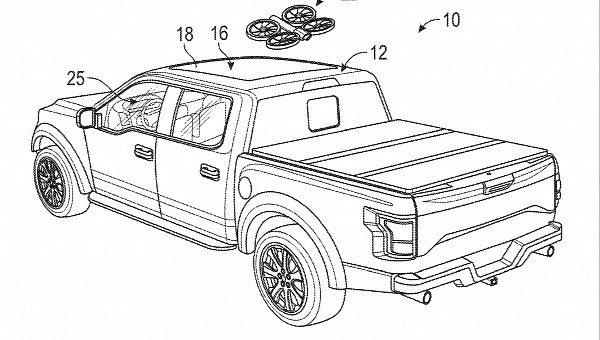Ford has recently patented new technology that would allow unmanned aerial vehicles, such as drones, to dock on the roof of its cars.
As unusual as this might sound, the American carmaker envisions a future where its very own vehicles can be used to charge and cool these flying machines, not only when parked but also in motion.
Described in a patent intuitively called “vehicle moonroof systems for docking and cooling unmanned aerial vehicles,” Ford’s idea relies on a special roof design that includes a dedicated opening for storing the necessary hardware aimed at charging and cooling drones.
The roof would therefore be fitted with a movable closure panel whose role would be to hide the drone base. In other words, when the opening is closed, the roof should sport a typical look similar to the one already available on Ford vehicles. When the moonroof opens, it would expose the docking system for the unmanned aerial vehicles, including the base and the hatch.
Drones would therefore be able to park on the roof of Ford cars automatically and connect to the dock for charging and cooling. This can happen both when the vehicle is in motion and when it is parked, as the flying machine can dock within the pod assembly when traveling at low speed.
While the whole thing sounds like Ford is getting ready for the future, the American carmaker’s idea doesn’t stop here. In some implementations, the company says it can equip the moonroof with a photovoltaic module whose role would obviously be to recharge the battery of the drone.
Cooling, on the other hand, can take place either when the vehicle is in motion by diverting the airflow through dedicated vents in the base or using an active system that controls the temperature when the Ford vehicle is parked.
Ford’s concept can be used in a wide variety of implementations, especially as the use of drones expands to new markets. For example, drones that are responsible for shipping the products you order online can use the vehicles on the road to recharge when heading back to the warehouse. Furthermore, such systems allow for more efficient cooling, especially during hot summer days when the autonomy of flying machines could be substantially impacted due to the high temperatures.
Amazon has also patented similar solutions in the past, and it’s not hard to imagine that such an approach would come in handy as it expands drone-powered shipping services to more regions. Amazon’s drones could eventually be able to recharge from the company’s trucks already on the road using an approach similar to the one described by Ford here.
Nevertheless, it’s important to keep in mind this idea is still a patent for the time being, so there’s no guarantee that such a solution would eventually make its way to mass production.
Described in a patent intuitively called “vehicle moonroof systems for docking and cooling unmanned aerial vehicles,” Ford’s idea relies on a special roof design that includes a dedicated opening for storing the necessary hardware aimed at charging and cooling drones.
The roof would therefore be fitted with a movable closure panel whose role would be to hide the drone base. In other words, when the opening is closed, the roof should sport a typical look similar to the one already available on Ford vehicles. When the moonroof opens, it would expose the docking system for the unmanned aerial vehicles, including the base and the hatch.
Drones would therefore be able to park on the roof of Ford cars automatically and connect to the dock for charging and cooling. This can happen both when the vehicle is in motion and when it is parked, as the flying machine can dock within the pod assembly when traveling at low speed.
While the whole thing sounds like Ford is getting ready for the future, the American carmaker’s idea doesn’t stop here. In some implementations, the company says it can equip the moonroof with a photovoltaic module whose role would obviously be to recharge the battery of the drone.
Cooling, on the other hand, can take place either when the vehicle is in motion by diverting the airflow through dedicated vents in the base or using an active system that controls the temperature when the Ford vehicle is parked.
Ford’s concept can be used in a wide variety of implementations, especially as the use of drones expands to new markets. For example, drones that are responsible for shipping the products you order online can use the vehicles on the road to recharge when heading back to the warehouse. Furthermore, such systems allow for more efficient cooling, especially during hot summer days when the autonomy of flying machines could be substantially impacted due to the high temperatures.
Amazon has also patented similar solutions in the past, and it’s not hard to imagine that such an approach would come in handy as it expands drone-powered shipping services to more regions. Amazon’s drones could eventually be able to recharge from the company’s trucks already on the road using an approach similar to the one described by Ford here.
Nevertheless, it’s important to keep in mind this idea is still a patent for the time being, so there’s no guarantee that such a solution would eventually make its way to mass production.






